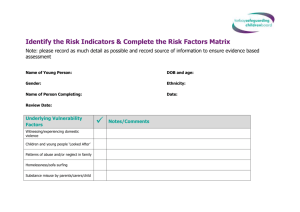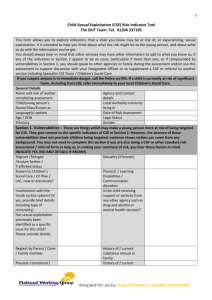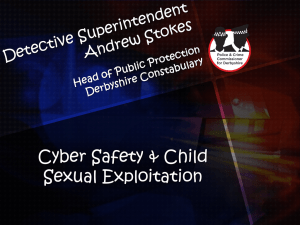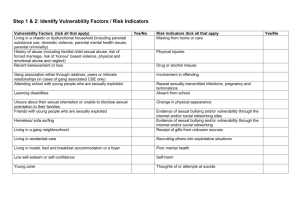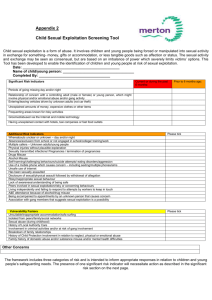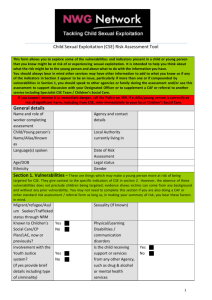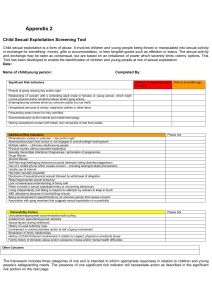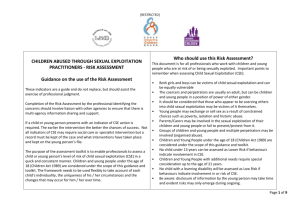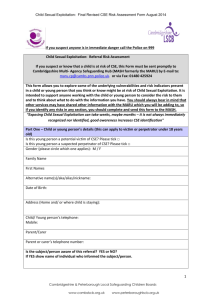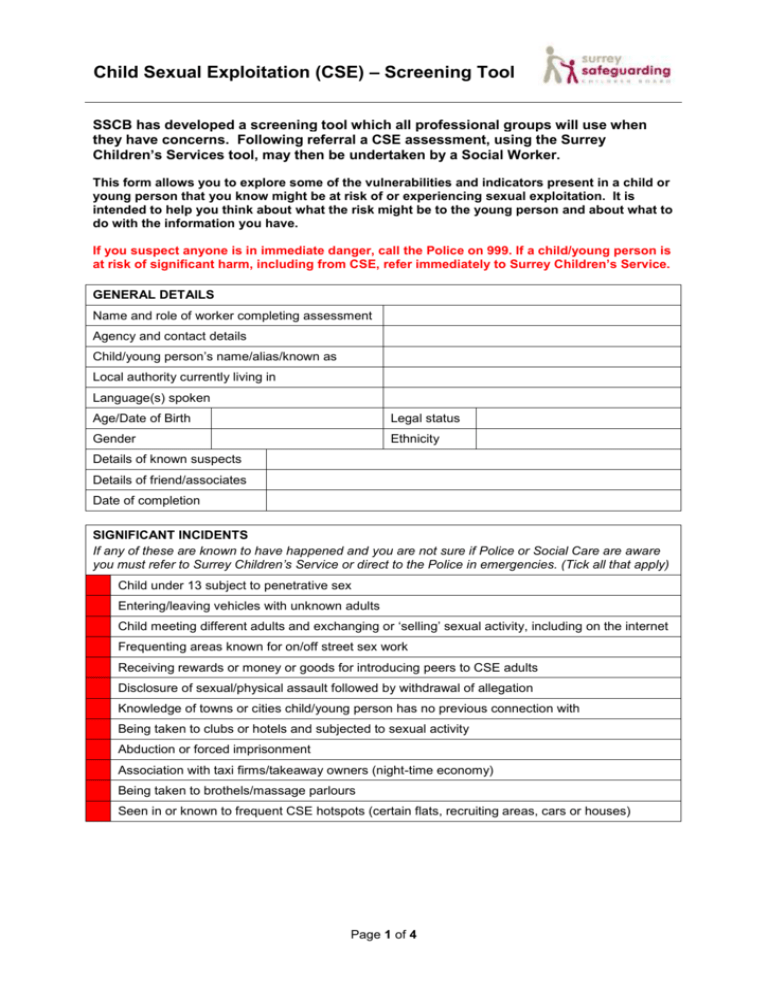
Child Sexual Exploitation (CSE) – Screening Tool
SSCB has developed a screening tool which all professional groups will use when
they have concerns. Following referral a CSE assessment, using the Surrey
Children’s Services tool, may then be undertaken by a Social Worker.
This form allows you to explore some of the vulnerabilities and indicators present in a child or
young person that you know might be at risk of or experiencing sexual exploitation. It is
intended to help you think about what the risk might be to the young person and about what to
do with the information you have.
If you suspect anyone is in immediate danger, call the Police on 999. If a child/young person is
at risk of significant harm, including from CSE, refer immediately to Surrey Children’s Service.
GENERAL DETAILS
Name and role of worker completing assessment
Agency and contact details
Child/young person’s name/alias/known as
Local authority currently living in
Language(s) spoken
Age/Date of Birth
Legal status
Gender
Ethnicity
Details of known suspects
Details of friend/associates
Date of completion
SIGNIFICANT INCIDENTS
If any of these are known to have happened and you are not sure if Police or Social Care are aware
you must refer to Surrey Children’s Service or direct to the Police in emergencies. (Tick all that apply)
Child under 13 subject to penetrative sex
Entering/leaving vehicles with unknown adults
Child meeting different adults and exchanging or ‘selling’ sexual activity, including on the internet
Frequenting areas known for on/off street sex work
Receiving rewards or money or goods for introducing peers to CSE adults
Disclosure of sexual/physical assault followed by withdrawal of allegation
Knowledge of towns or cities child/young person has no previous connection with
Being taken to clubs or hotels and subjected to sexual activity
Abduction or forced imprisonment
Association with taxi firms/takeaway owners (night-time economy)
Being taken to brothels/massage parlours
Seen in or known to frequent CSE hotspots (certain flats, recruiting areas, cars or houses)
Page 1 of 4
VULNERABILITIES
These are things which may make a young person more at risk of being targeted for CSE. They give
context to the specific indicators of CSE in the next section. However, the absence of these
vulnerabilities does not preclude children being targeted; evidence shows victims can come from
any background and without any prior vulnerability. (Tick all that apply)
Migrant/refugee/asylum seeker/trafficked status through National Referral Mechanism (NRM)
Known to Children’s Social Care/CP Plan/LAC, now or previously
Physical/learning disabilities/communication disorders
Involvement with Youth Justice
Is the child receiving support or services from any other agency, such as drug/alcohol or mental
health services?
Has sexual exploitation previously been identified as a specific issue for this child?
Neglect by parent/carer/family member
History of/current domestic abuse (including risk of forced marriage/honour based
violence/familial child sexual abuse)
Physical/emotional/sexual abuse by parent/carer/family member
History of/current substance misuse in family
Poverty or deprivation
Family history of exploitation or prostitution
Unsuitable or inappropriate accommodation (inc. street homelessness, staying with inappropriate
adults/hostel/B&B)
Family history of mental health difficulties impacting parenting
Breakdown of family relationships
Family bereavement
Low self-esteem or history of being bulled or bullying
Lack of positive relationship with a protective/nurturing adult
Recent bereavement or loss
Young carer
Disconnecting from support networks, i.e. family/friends
Living in a chaotic or dysfunctional household
Unsure about sexual orientation or unable to disclose sexual orientation to their families/friends
Ethnicity (bullying)
RISK INDICATORS
Children are groomed and exploited in different ways. Below are some signs that may signify if the
child is being groomed for sexual exploitation or actually being sexual exploited. (Tick all that apply)
Within family/home/relationships
Change in behaviour – being more secretive/withdrawn/isolated from peers or not mixing with
usual friends
Increasingly disruptive, hostile or physically aggressive at home or school, including use of
sexualised language
Associating/relationship with significantly older men or women who encourage emotional
dependence, loyalty and isolation from safe
Physical or emotional abuse by a boyfriend/girlfriend or controlling adult including use of
manipulation, violence and/or threats
Associating with other sexually exploited children
Page 2 of 4
Multiple callers (unknown adults/older young people)
Estranged from family
Regularly coming home late or going missing from home, care or education for any period of time
(whether reported or not)
Returning home after long intervals appearing well cared for
Health and mental health
Change in physical appearance (new clothes, more/less make-up, weight gain/loss)
Increased health/sexual health related problems
Marks or scars or physical injuries on the body or face which there are attempts to conceal
Expressions of despair (including: depression, mental ill health, self harm, suicidal
thoughts/attempts, overdose, eating disorder)
Branding (i.e. of gang logos)
Repeat/unplanned pregnancy or pregnancies (including ending in termination/miscarriage(s))
Sexually transmitted infections (STIs) and/or repeat tests particularly with negative results
Behaviour and experiences
Concealed/concerning use of the internet including webcam, on-line gaming (via X-box,
PlayStation) chat rooms, etc
Exclusion from school or unexplained absences from, or not engaged in
school/college/training/work
Failing to respond to attempts to keep in touch by workers/carer or recent disengagement
Reports of being taken to hotels, nightclubs, takeaways or out of area by unknown adults
Sexualised risk-taking, including on internet or mobile phone, such as sexting (sending explicit
messages or photos to adults or peers)
Young gay/bisexual exploring sexuality in unsupported way
Association with gangs/fear of victimisation by gangs
Increasing use of drugs or alcohol or misuse of drugs or alcohol
Inability to negotiate exit from a gang due to fear/dependency
Displaying signs of harassment/unwanted attention
Evidence of sexual bullying and/or vulnerability through the internet and/or social networking sites
Involved in criminal offending activity (i.e. anti-social behaviour/criminal damage/theft)
Unusual association with groups of adults
Appearance and possessions
Unexplained amounts of money, mobiles, credit, expensive clothing, jewellery or other items/gifts
Inappropriate style of dress
Having multiple mobile phones, sim cards or use of a phone that causes concern – multiple
callers or more texts/pings than usual
Possession of hotel keys/cards or keys to unknown premises
Is there a risk present to others, i.e. other child/vulnerable adult?
Please add any additional information that you feel is unusual/relevant/concerning and include
any
Please comment on the robustness of the concern / data source.
Page 3 of 4
Analysis
Professional judgement:
This form is a guide to professionals and there is no set number of criteria that need to be met, but
professionals are encouraged to reflect upon the indicators and vulnerabilities and exercise their own
judgement.
What does the above
information tell you about
this child and the risk to them
of CSE?
Using the guidance below,
what would you grade the
risk to be?
(insert RAG rating – see guidance below)
Outcome of analysis
High
“A young person, whose sexual exploitation is habitual, often
self-denied and where coercion and control is implicit”.
There are urgent and immediate concerns about Risk.
There are multiple risk factors: i.e.
o Repeat missing episodes
o Contact with known perpetrators
o Established drug and alcohol problems
o Experience of violence
o Intimidation and fear
o Risk taking behaviour
o Multiple abusive relationships
Please refer to list on page 1
Medium
“Evidence that a child or young person is being targeted for
opportunistic abuse, through the exchange of sex for drugs,
perceived affection, sense of belonging, accommodation
(overnight stays), money/goods etc. The likelihood of
coercion and control is significant”.
There are fewer risk factors, but some of their behaviour puts
them at risk, e.g.
o Their association with peers also at risk of CSE
o They frequent known CSE hotspots
o They are truanting and occasionally going missing.
Some protective factors do exist though e.g. they are engaging in
school.
Low
“A vulnerable child / young person, where there are concerns
they are being targeted and groomed and where any of the
CSE warning signs have been identified”.
There is no evidence of offences.
There are less risk indicators / they are showing early signs of
risk indicators.
They are exiting exploitation.
The concerns appear to relate to normal teenage behaviour
NEXT STEPS
Action(s) already taken or to be
taken with timescales:
Done – include summary of action taken and date completed
To be done – include timescales and any appropriate details
Discuss with line manager or
CSE Champion
Refer to Children’s Service
Discuss with Police
Any other actions, treatment or
monitoring arrangements
Page 4 of 4

